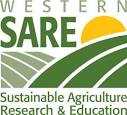About
This website describes three research projects on the effects of legume grass mixtures on dairy cattle performance and heifer development. As publications, presentations and trial results from the projects become available, we will make them available here.
Background
Dairy cattle raised according to National Organic Program requirements must be managed on pasture and graze daily throught the growing season, so it can be both challenging and costly for organic producers to develop heifers so that they are ready for breeding within 15 months.
Project Objectives
Researchers at Utah State University, the University of Idaho, and the USDA-ARS are working with producers and extension educators to improve the economic and environmental sustainability of pasture-based organic dairies by examining the effects of legume-grass mixtures on dairy cattle performance and heifer development. This website describes three projects, funded by NIFA OREI and Western SARE. The goal of the research is to develop an exclusively forage-based, organic system for dairy heifer development, and then to inspire widespread adoption of these practices. Our central hypothesis is that high energy grasses in combination with birdsfoot trefoil, which is a high protein condensed tannin-containing legume, will maximize growth, health, and reproductive characteristics in developing organic dairy heifers, along with improved nutrient cycling and economic sustainability.
Project Descriptions
In 2017, Western SARE awarded a grant to Blair Waldron of the USDA-ARS in Logan, Utah, for the project "Grass-birdsfoot trefoil mixtures to improve the economic and environmental sustainability of pasture-based organic dairies in the western U.S." For this project, we conducted university and on-farm trials to assess dairy heifer dry matter intake, health, reproductive performance, economics, and the impact on nitrogen cycling in response to grazing grass-birdsfoot trefoil mixtures containing various protein, energy, preference, and tannin levels. A full description of the project objectives and a final report is available at https://projects.sare.org/project-reports/sw17-046/
Also in 2017, a NIFA OREI grant was awarded to Clay Isom for the project "Economic and Environmental Sustainability of Forage-Based Heifer Development Strategies in Pasture-Based Organic Dairy Systems". In this project, we seek to determine the relative forage production potential and dairy cattle dry matter intake (DMI) in response to grazing grass-legume mixtures containing various tannin, protein, and energy levels, and assess their effects on dairy heifer health, growth, and reproductive performance. We will also evaluate the impact on nitrogen cycling, and conduct a comprehensive assessment of the economic sustainability of the various forage-based heifer development programs. A full description of the project is available here.
In 2021, a second WSARE project was funded: "Dry Matter Intake and Feed Efficiency of Four Dairy Breeds in a Pasture-Based Heifer Development Program". This project expands upon our previous studies, which found that forage characteristics only explained 50% of the variation in DMI and average daily gain (ADG). Furthermore, producers on our research team wanted to learn more about the influence of dairy breed on performance within their pasture-based systems. In this project, we are investigating the effects of dairy breed, pasture type, and breed-by-pasture type interactions on DMI, feed efficiency, and environmental and economic sustainability of heifers raised in pasture-based systems. A multi-disciplinary team is conducting this research at the Utah State University Lewiston Pasture Research Facility where replicated pastures of grass monoculture (MONO) or grass-birdsfoot trefoil (MIXED) are established. Four breeds of dairy heifers (Holstein, Jersey, Holstein/Jersey crossbreds, and 3-way Holstein/Montbeliarde/Viking Red crossbreds [i.e., ProCROSS]) will be compared as they rotationally graze pasture treatments (MONO vs MIXED) throughout the summer. Producer cooperators will provide dairy heifers and participate in DMI and forage evaluation of pastures on their dairies.
Funding
Funding for these projects was provided by

Western SARE grants SW17-046 and 2SW21-927

USDA NIFA OREI grant 2017-51300-26866
